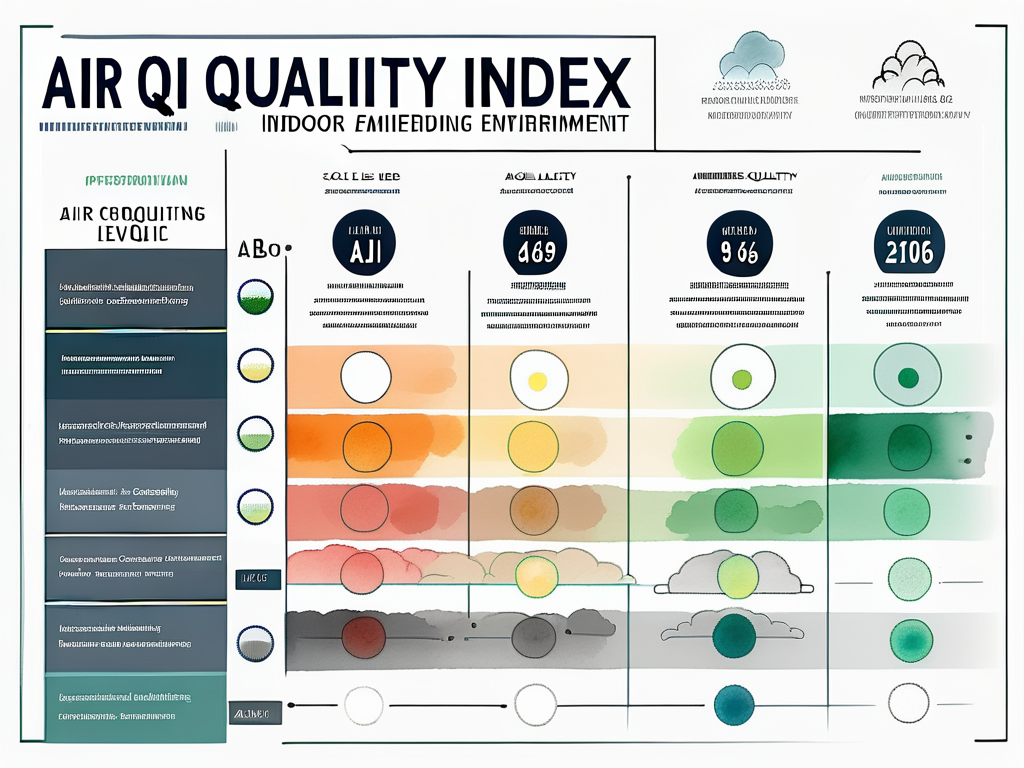The Air Quality Index (AQI) is a crucial tool used worldwide to measure and communicate the quality of air in a given area. This system provides a standardised way of comparing air quality across different regions and times, making it an essential resource for environmental scientists, health professionals, and the general public. It’s particularly important when considering indoor air quality, which can significantly impact our health and well-being.
Indoor air quality refers to the air quality within and around buildings and structures, especially as it relates to the health and comfort of building occupants. Understanding and controlling common pollutants indoors can help reduce your risk of indoor health concerns. This glossary entry will delve into the intricacies of the Air Quality Index and its relevance to indoor air quality, providing a comprehensive understanding of these critical topics.
Understanding the Air Quality Index (AQI)
The Air Quality Index (AQI) is a numerical scale used for reporting daily air quality. It tells you how clean or polluted your air is, and what associated health effects might be a concern for you. The AQI focuses on health effects you may experience within a few hours or days after breathing polluted air. The Environmental Protection Agency (EPA) calculates the AQI for five major air pollutants regulated by the Clean Air Act.

These pollutants include ground-level ozone, particle pollution (also known as particulate matter), carbon monoxide, sulfur dioxide, and nitrogen dioxide. For each of these pollutants, the EPA has established national air quality standards to protect public health. The AQI value is calculated for each of these pollutants, and the highest of these AQI values is reported as the AQI value for that day.
How the AQI is Calculated
The AQI is calculated using a complex algorithm that converts raw data on pollutant concentrations into a number on the AQI scale, which ranges from 0 to 500. The higher the AQI value, the greater the level of air pollution and the greater the health concern. An AQI value of 100 generally corresponds to the national air quality standard for the pollutant, which is the level EPA has set to protect public health.
AQI values below 100 are generally thought of as satisfactory. When AQI values are above 100, air quality is considered to be unhealthy, at first for certain sensitive groups of people, then for everyone as AQI values get higher. The AQI is divided into six categories, each corresponding to a different level of health concern.
The AQI Scale and What it Means
The AQI scale is divided into six categories, each representing a different level of health concern. Each category corresponds to a different color, making it easy to visually interpret the AQI. The six levels are: Good (0-50), Moderate (51-100), Unhealthy for Sensitive Groups (101-150), Unhealthy (151-200), Very Unhealthy (201-300), and Hazardous (301-500).
Each category comes with its own set of recommendations for protecting your health. For example, when the AQI is in the ‘Unhealthy’ range, people with heart or lung disease, older adults, and children should avoid prolonged or heavy exertion. Everyone else should reduce prolonged or heavy exertion. When the AQI is ‘Hazardous’, everyone should avoid all physical activity outdoors.
Indoor Air Quality (IAQ)
Indoor Air Quality (IAQ) refers to the air quality within and around buildings and structures, particularly as it relates to the health and comfort of building occupants. IAQ can be affected by a variety of factors, including but not limited to: gases (such as carbon monoxide, radon, volatile organic compounds), particulates, microbial contaminants (mould, bacteria), and any mass or energy stressor that can induce adverse health conditions.
Indoor air quality is a significant concern because it can affect the health, comfort, and productivity of building occupants. The EPA has found that concentrations of some pollutants can be 2 to 5 times higher indoors than typical outdoor concentrations. People who are often most susceptible to the adverse effects of pollution (e.g., the very young, older adults, people with cardiovascular or respiratory disease) tend to spend even more time indoors.
Common Indoor Air Pollutants
There are many sources of indoor air pollution in any home. These include combustion sources such as oil, gas, kerosene, coal, wood, and tobacco products; building materials and furnishings as diverse as deteriorated, asbestos-containing insulation, wet or damp carpet, and cabinetry or furniture made of certain pressed wood products; products for household cleaning and maintenance, personal care, or hobbies; central heating and cooling systems and humidification devices; and outdoor sources such as radon, pesticides, and outdoor air pollution.
The relative importance of any single source depends on how much of a given pollutant it emits and how hazardous those emissions are. In some cases, factors such as how old the source is and whether it’s properly maintained are significant. For example, an improperly adjusted gas stove can emit significantly more carbon monoxide than one that’s properly adjusted.
Effects of Poor Indoor Air Quality
Poor indoor air quality can lead to a variety of health problems. Immediate effects may show up after a single exposure or repeated exposures to a pollutant. These include irritation of the eyes, nose, and throat, headaches, dizziness, and fatigue. Such immediate effects are usually short-term and treatable. Sometimes the treatment is simply eliminating the person’s exposure to the source of the pollution, if it can be identified.
Long-term effects can include respiratory diseases, heart disease, and cancer, and can be severely debilitating or fatal. It is prudent to try to improve the indoor air quality in your home even if symptoms are not noticeable. More research is needed to better understand which health effects occur after exposure to the average pollutant concentrations found in homes and which occur from the higher concentrations that occur for short periods of time.
Monitoring Indoor Air Quality
Monitoring indoor air quality is crucial for maintaining a healthy indoor environment. There are several ways to monitor indoor air quality, ranging from simple do-it-yourself methods to professional testing. Some common methods include using carbon monoxide detectors, radon test kits, mould test kits, and professional air quality testing services.

Professional air quality testing can provide a comprehensive assessment of the pollutants in your home, including volatile organic compounds (VOCs), particulate matter, and biological pollutants like mould and bacteria. These tests can be expensive, but they provide the most accurate results and can be invaluable in identifying and addressing serious air quality problems.
Improving Indoor Air Quality
There are several strategies to improve indoor air quality. The most effective way is to eliminate individual sources of pollution or to reduce their emissions. Some sources, like those that contain asbestos, can be sealed or enclosed; others, like gas stoves, can be adjusted to decrease the amount of emissions. In many cases, source control is also a more cost-efficient approach to protecting indoor air quality than increasing ventilation because increasing ventilation can increase energy costs.
Another approach to lowering the concentrations of indoor air pollutants in your home is to increase the amount of outdoor air coming indoors. Most home heating and cooling systems, including forced air heating systems, do not mechanically bring fresh air into the house. Opening windows and doors, operating window or attic fans, when the weather permits, or running a window air conditioner with the vent control open increases the outdoor ventilation rate.
Role of Air Purifiers
Air purifiers can play a role in improving indoor air quality. These devices work by removing pollutants from the air. They can be particularly helpful for people who are sensitive to air pollution, such as individuals with allergies or asthma. However, while air purifiers can help improve indoor air quality, they are not a substitute for proper ventilation and source control of pollutants.
There are several types of air purifiers, including mechanical filters, activated carbon filters, ozone generators, and electronic air purifiers. Each type has its strengths and weaknesses, and the best choice depends on the specific needs of the individual. For example, mechanical filters are very effective at removing particulate matter, but they do not remove gases and odors. Activated carbon filters are excellent at removing gases and odors, but they are not very effective at removing particulate matter.
Conclusion
Understanding the Air Quality Index and its implications for indoor air quality is crucial for maintaining a healthy living environment. By monitoring indoor air quality and taking steps to improve it, individuals can reduce their risk of health problems related to air pollution. While the AQI is a valuable tool for understanding outdoor air quality, it’s important to remember that indoor air quality can be significantly worse than outdoor air quality, making it even more important to monitor and improve the air quality in our homes.

While this glossary entry has provided a comprehensive overview of the AQI and indoor air quality, it’s important to remember that this is a complex topic with many nuances. Further research and consultation with professionals may be necessary to fully understand the air quality in your specific environment and to develop an effective strategy for improving it.




